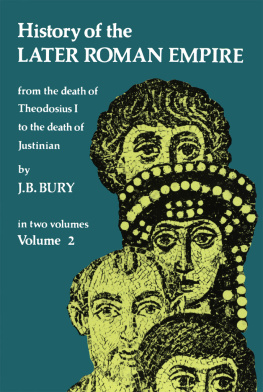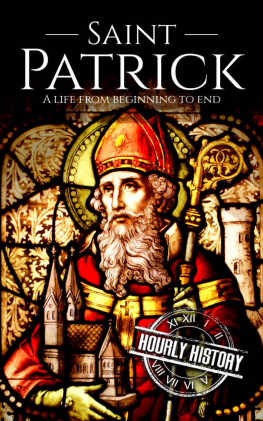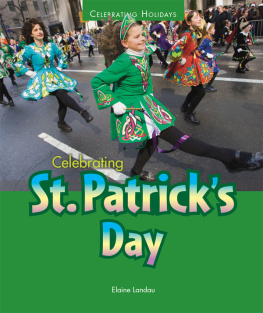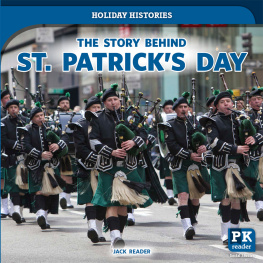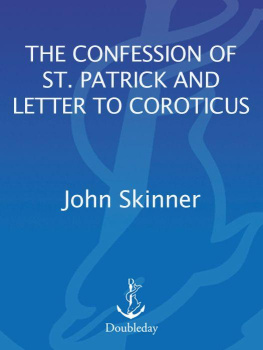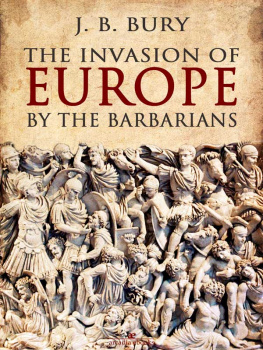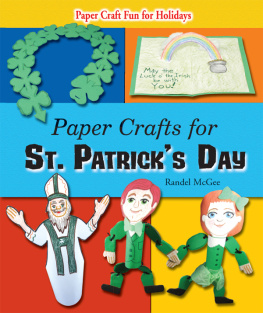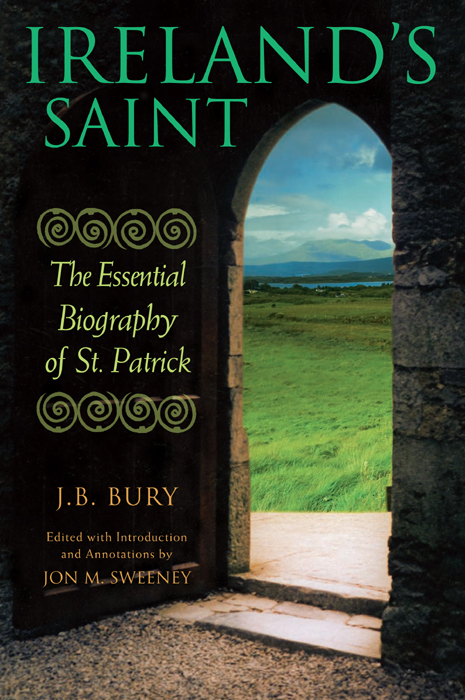Praise for Irelands Saint
Bury proves to be more than a mere dry historian; he turns out to be a fine storyteller as well, and his accounts of Patricks spiritual duels with Druid priests for the heart and mind of the Irish king are quite gripping.
History Book Club
Editor-writer Sweeney gives Burys 1905 biography of the legendary St. Patrick a greater contemporary context in this meticulously researched and presented work . Bury wrote what Sweeney calls the ideal modern biography of Patrick . Sweeney assembles and rearranges material from Burys original work and incorporates more of Patricks own words, from his Confession and Letter against Coroticus. Sweeneys light edits to Burys text clarify exactly what Patrick did in Ireland, noting that although he did convert some pagan kingdoms, he also was responsible for organizing Christians who were already there and connecting the island with the church of the Roman Empire.
Publishers Weekly

Jon M. Sweeney is an editor and writer best known for his editing of Paul Sabatiers classic biography The Road to Assisi: The Essential Biography of St. Francis, which has sold more than 40,000 copies, and was a featured selection of The History Book Club and Book-of-the-Month Club. The third volume in this seriesThe Road to Siena: The Essential Biography of St. Catherine, is also now available. He lives in Vermont.
J. B. Bury (18611927) was an Irish historian and an expert on the Greek and Roman Empires. He grew up in County Monaghan the son of an Anglican rector and was made a fellow of Trinity College in Dublin at the young age of 24. In 1902, Bury was appointed the prestigious Regius Professor of Modern History at Cambridge University, a position he held until his death. He wrote many scholarly works, including History of the Later Roman Empire, Invasion of Europe by the Barbarians, and this biography of St. Patrick of Ireland.

Mosaic of St. Patrick, Westminster Cathedral, London
Irelands Saint: The Essential Biography of St. Patrick
2010 First Paperback Printing
2008 First Hardcover Printing
Copyright 2008 by Jon M. Sweeney
ISBN: 978-1-55725-682-9
The Library of Congress has catalogued the hardcover edition as follows:
Bury, J. B. (John Bagnell), 18611927.
Irelands saint : the essential biography of St. Patrick / J.B. Bury; introduction and annotations by Jon M. Sweeney.[New ed.].
p. cm.
Rev. ed.: The life of St. Patrick and his place in history, 1905.
Includes index.
ISBN-13: 978-1-55725-557-0
1. Patrick, Saint, 373?463? 2. Christian saintsIrelandBiography. 3. IrelandChurch historyTo 1172. I. Bury, J. B. (John Bagnell), 18611927. Life of St. Patrick and his place in history. II. Title.
BX4700.P3B8 2008
270.2092dc22 2008017071
10 9 8 7 6 5 4 3 2 1
All rights reserved. No part of this book may be reproduced, stored in an electronic retrieval system, or transmitted in any form or by any meanselectronic, mechanical, photocopy, recording, or any otherexcept for brief quotations in printed reviews, without the prior permission of the publisher.
Published by Paraclete Press
Brewster, Massachusetts
www.paracletepress.com
Printed in the United States of America
F OR
Sarah-Maria and Joseph,
who remind me of Patricks words in the Confession,
I ought to give thanks to God without ceasing.
J.M.S.

CONTENTS
INTRODUCTION
First published in 1905, John Bagnell Burys (18611927) biography of St. Patrick of Ireland was the most influential study of the saint ever written up until that point. Burys scholarship and conclusions directed the understanding of Patrick for at least a half century. Almost immediately, for instance, he overturned long-standing tradition that held that Patricks mission lasted sixty years and the saint died in 493. Bury said Patricks mission was only thirty years, the additional thirty were added by early hagiographers, and Patrick passed away in 461.
The original title of Burys book was The Life of St. Patrick and His Place in History. Bury was an Irish historian, and an expert on the Greek and Roman Empires. He was also a Protestant, which might be unnecessary to mention under other circumstances; however, in the case of Irish history, it is unavoidable. He grew up in County Monaghan, the son of an Anglican rector. He was made a fellow of Trinity College in Dublin at the young age of twenty-four, and became recognized as expert in ancient, medieval, and modern history over the course of the next decades. In 1902, Bury was appointed the prestigious Regius Professor of Modern History at Cambridge University, a position he held until his death. Modern, in this instance, refers to all but ancient. Subsequent holders of the title have included George Macaulay Trevelyan, Herbert Butterfield, and William Owen Chadwick. A senior professorship by the same name exists at Oxford.
As he mentions in the first sentence of his original preface, Bury was attracted to the subject of St. Patrick not as an important crisis in the history of Ireland, but, in the first place, as an appendix to the history of the Roman Empire, illustrating the emanations of its influence beyond its own frontiers. Burys earlier writings spanned the ancient Greeks and Romans, throughout the Middle Ages, and into Victorian history. But he was considered expert, most of all, on the later Roman Empire. Some of his many writings on the subject include History of the Later Roman Empire (still in print in 2 volumes), Invasion of Europe by the Barbarians (recently reissued), and History of the Eastern Roman Empire. One of the primary emphases of his biography of Patrick is to place the Ireland of Patricks day in the proper historical context, as influenced by the Germanic and Scandinavian invasions of the third to ninth centuries, but also, in many ways, to portray it as stubbornly apart from the empire. His biography of Patrick has been accurately described as a postscript to the authors history of the later Roman Empire, dealing with the final episode in the spread of Roman civilization (which by this time happened to include Christianity also) among the barbarian peoples (Binchy, 10).
Many scholars today argue with Burys conclusions, saying that we cannot know as much as he claims to have discovered in the sources. [The] Patrick of current mythology has been put together mainly from an oblique inheritance from a long series of Lives, writes one of these (Thomas, 309). In other words, Bury may have brought Patrick scholarship into the modern era, but he still contributes to the perpetuation of stories we cannot fully substantiate. According to this line of thinking, only the writings of Patrickthe Confession, written when Patrick was an old man responding to charges made against him by British priests, and the


